Haarlem, a city with a rich history and stunning architecture, offers visitors a unique opportunity to admire its beauty from the water. A canal cruise unfolds an enchanting panorama of historic buildings and picturesque bridges. In this article, we delve deeper into the fascinating world of Haarlem's bridges and discover what makes them so special.
Why are Haarlem's bridges so special?
Haarlem's bridges are more than just functional connections; they are living witnesses to the city's rich past and architectural heritage. Each bridge tells a unique story, interwoven with the history of the city and its people.
Haarlem's bridges are distinguished by their harmonious integration into the urban landscape. They not only form crucial links in the transportation network but also contribute to the city's aesthetic appeal. The combination of medieval, Renaissance, and modern elements in the design of these bridges reflects Haarlem's evolution over the centuries.
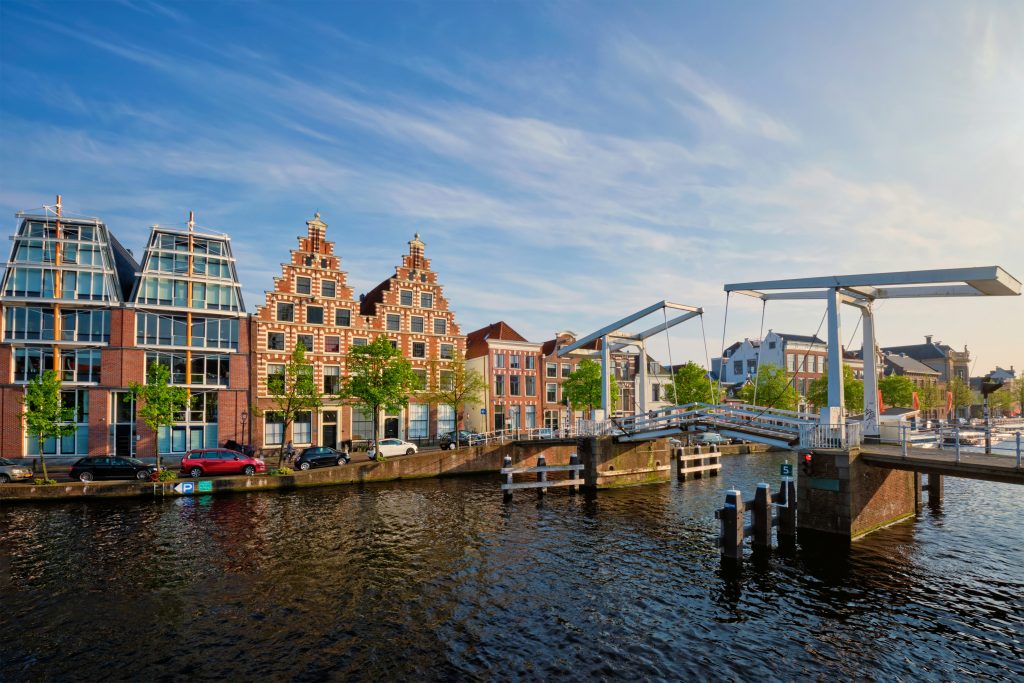
How has Haarlem's history influenced the architecture of its bridges?
The architecture of Haarlem's bridges is deeply rooted in the city's historical development. During the Golden Age, when Haarlem was a thriving center of trade and culture, many bridges were built or renovated to accommodate the growing population and increasing commercial activity. This period left an indelible mark on the bridges' design, with elegant arches and refined ornamentation reflecting the prosperity and artistic flair of the time.
The Industrial Revolution brought new materials and techniques, leading to the introduction of iron and later steel bridges. These innovations allowed engineers to create larger spans while preserving Haarlem's characteristic charm. The result is a fascinating blend of old and new elements that make Haarlem's bridges unique in the Netherlands.
What historical events have left their mark on the bridges?
- The Siege of Haarlem (1572-1573): Some bridges still bear the scars of this dramatic episode, with fortifications built to defend the city.
- The Golden Age (17th century): This period of economic prosperity resulted in the construction of graceful bridges that reflected the city's wealth.
- Industrialization (19th century): The advent of new materials and techniques led to the construction of sturdier bridges that could handle larger traffic flows.
- Post-WWII Reconstruction: Although Haarlem was relatively spared, some bridges were restored or rebuilt, integrating modern elements into historical designs.
What is the Gravestenen Bridge and why is it a must-see?
The Gravestenenbrug is an architectural gem spanning the Bakenessergracht canal. With its characteristic arched structure and ornate balustrades, this bridge is a magnificent example of 17th-century bridge architecture. What makes the Gravestenenbrug so special is not only its aesthetic beauty but also its rich history, which dates back to the early days of Haarlem's urban development.
Passing under the Gravestenen Bridge during a canal cruise is like stepping through a time portal. The bridge offers a unique perspective on the historic buildings lining the canal, and the reflection of the arch in the water creates a captivating visual effect that has inspired photographers and artists for centuries.
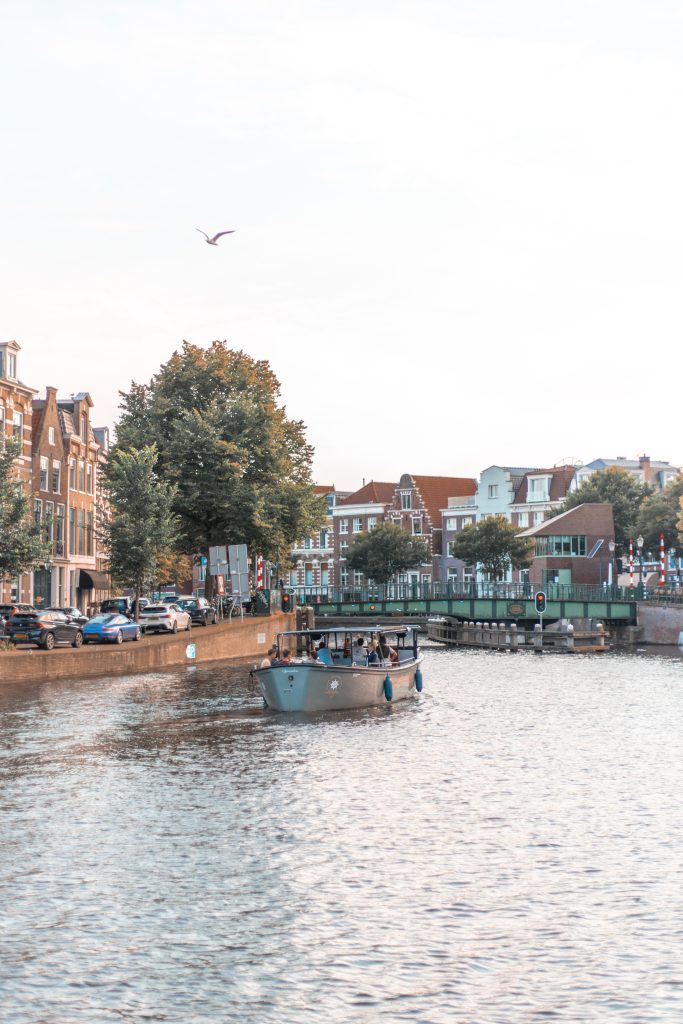
How old is the Gravestenen Bridge and what is its history?
The Gravestenen Bridge dates from 1634, a period when Haarlem flourished as one of the most important cities in the Netherlands. The bridge was built to accommodate the growing population and increasing trade. Its design reflects the architectural style of the Golden Age, perfectly balancing functionality and aesthetics.
Interestingly, the name "Gravestenenbrug" refers to the tombstone-like stones used in its construction. These stones, known for their durability, were a popular building material at the time and contributed to the bridge's longevity. Over the centuries, the Gravestenenbrug has undergone numerous renovations and restorations, but its original charm and character have been preserved.
| Year | Event |
|---|---|
| 1634 | Construction of the Gravestenen Bridge |
| 1784 | First major renovation |
| 1923 | Reinforcement of the foundation |
| 2008 | Extensive restoration with preservation of historical elements |
Why is the Catharijne Bridge considered a masterpiece?
The Catharijne Bridge, an imposing swing bridge spanning the Spaarne River, is often considered a technical and aesthetic masterpiece. Built in 1902, it marks a pivotal moment in the history of Dutch bridge building, combining innovative engineering with a refined design that reflects Haarlem's historic character.
What makes the Catharijne Bridge so special is how it addresses the challenges of modern mobility without compromising the visual harmony of its surroundings. The elegant iron structure, with its characteristic green color, forms a beautiful contrast with the brick facades of the surrounding buildings. During a canal cruise, the opening and closing of this bridge is a spectacle in itself, demonstrating the ingenious mechanics behind this architectural marvel.
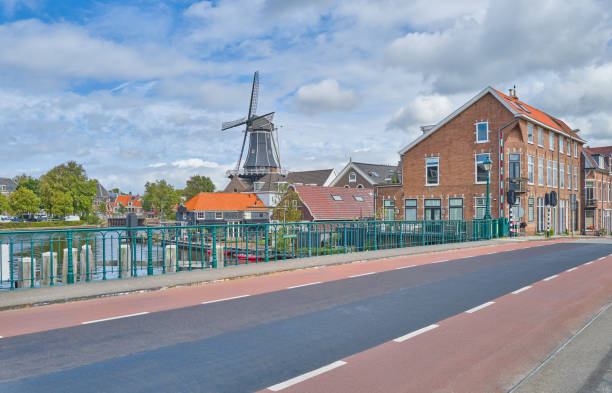
How does the Catharijne Bridge combine functionality with aesthetics?
The Catharijne Bridge is a textbook example of how functionality and aesthetics can go hand in hand. The bridge not only had to accommodate the busy traffic on the Spaarne River but also allow large ships to pass through. The engineers and architects who designed the bridge faced the challenge of creating a structure that was both robust and elegant.
The solution was a swing bridge with a balanced design. The bridge's symmetrical structure, with its characteristic lanterns and graceful railings, creates a visually appealing whole. At the same time, the sophisticated swing mechanism allows the bridge to be opened quickly and efficiently for passing ships. This combination of form and function makes the Catharijne Bridge a true masterpiece of civil engineering and architectural design.
What role does the Catharijnebrug play in the daily lives of Haarlem residents?
- Traffic junction: The bridge connects the city centre with the eastern neighbourhoods of Haarlem.
- Meeting place: Many locals meet at the bridge because of its central location.
- Tourist attraction: The bridge attracts many visitors every day who want to admire its technical operation.
- Cultural symbol: The Catharijne Bridge has become an icon of Haarlem's industrial heritage and innovative spirit.

What makes the Melkbrug so photogenic?
The Melkbrug, a charming pedestrian bridge over the Spaarne River, is a favorite among photographers and artists. This elegant arched bridge, with its white-painted balustrades and classic lanterns, offers a timeless image that fits perfectly into Haarlem's historic setting. The Melkbrug's photogenic qualities are due to a combination of factors that create a visual feast.
What makes the Melkbrug so special for photographers is the way the light and surroundings work together to create an ever-changing scene. Whether it's the golden glow of the setting sun illuminating the white balustrades, or the misty mornings when the bridge rises from the water like a ghostly apparition, there's always a unique perspective to be found. The reflections in the Spaarne River add an extra dimension to the composition, making every photo of the Melkbrug a work of art in itself.
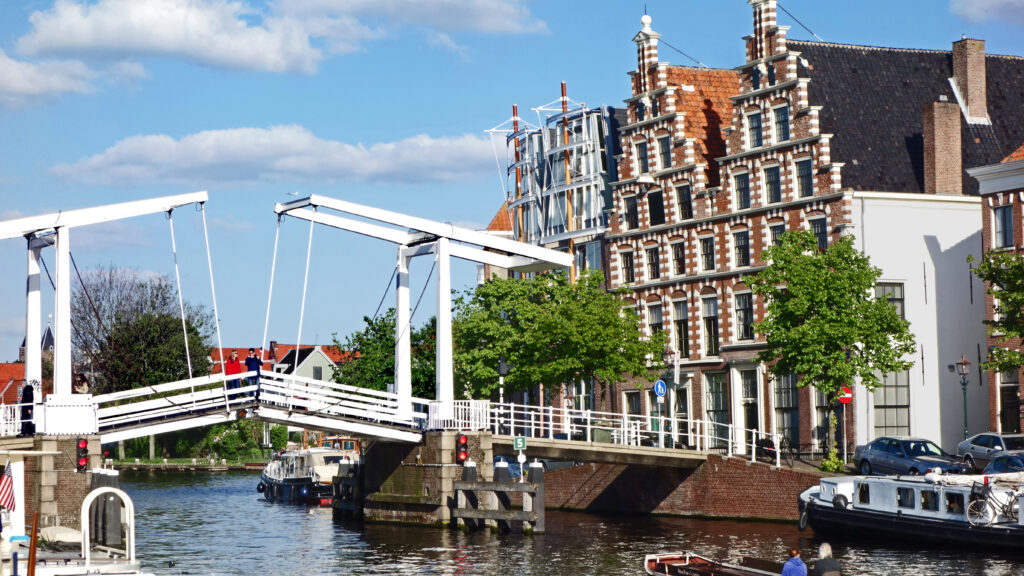
How does the location of the Melkbrug contribute to its beauty?
The Melkbrug's strategic location plays a crucial role in its appeal. Situated in the heart of Haarlem, the bridge offers a perfect vantage point over the historic city center. On one side, you have a view of the imposing St. Bavo Church, while on the other, you can see the characteristic Dutch facades of Spaarnewouderstraat. This unique position makes the Melkbrug a kind of gateway between two different worlds of Haarlem's rich architectural heritage.
Moreover, the bridge's orientation allows photographers to benefit from optimal lighting conditions at different times of day. During the golden hour, just before sunset, the bridge is bathed in a warm, golden light that accentuates the white balustrades and casts long shadows across the water. In the early morning, when a light mist often hangs over the Spaarne River, the Melkbrug takes on an almost ethereal quality that captures the imagination.
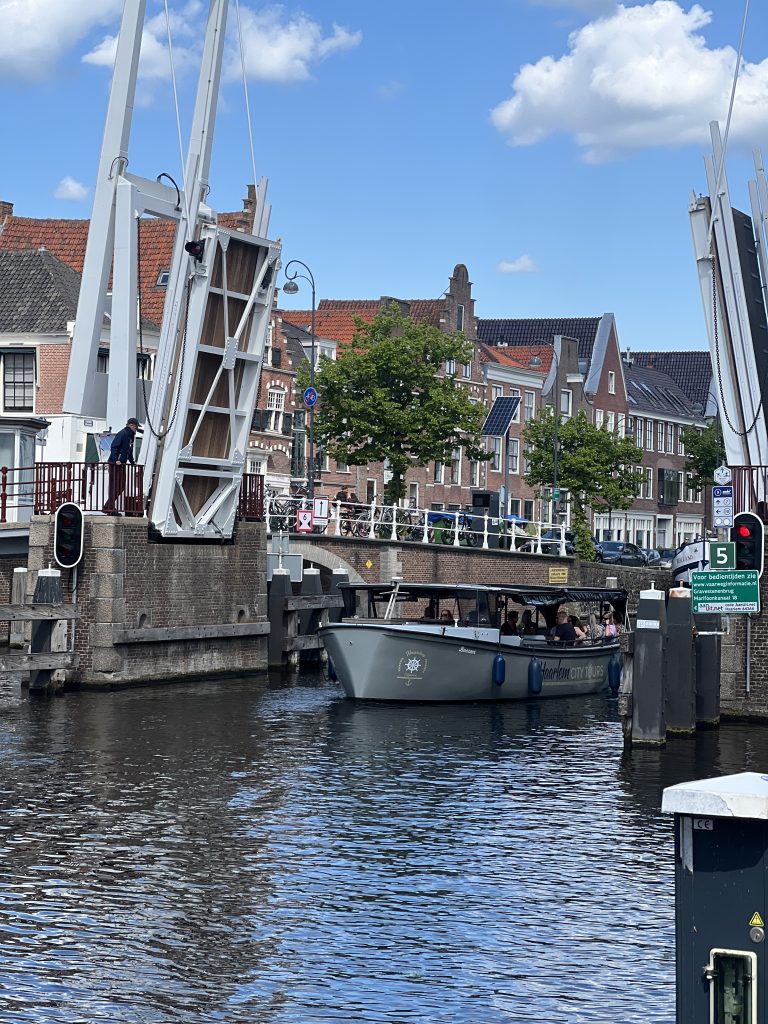
What tips do professional photographers have for capturing the Melkbrug?
- Timing is everything: Try to photograph the bridge during the golden hour for the most beautiful light.
- Experiment with perspectives: Photograph the bridge from both the shore and a boat for unique angles.
- Use reflections: Take advantage of the reflection in the water for symmetrical compositions.
- Long shutter speed: Try using a long shutter speed at night to capture the light trails of passing boats.
- Include context: Include elements of the surrounding area in your photos to place the bridge in its historical context.
How can you best enjoy these bridges during a boat tour?
A canal cruise is undoubtedly the best way to experience the full splendor of Haarlem's bridges. From the water, you get a unique perspective that simply can't be matched from dry land. The gentle rocking of the boat, combined with the calm lapping of the water, creates a serene atmosphere perfect for taking in the architectural beauty of the bridges.
To fully enjoy your canal cruise, it's recommended that you read up on the history and specifics of each bridge beforehand. Many canal boats offer guides who share fascinating stories and trivia, but it can also be fun to explore on your own. Take your time to observe the details of each bridge—from the graceful arches to the hidden ornaments—and let yourself be swept away by the romance of Haarlem's canals.
Which boat tour route do local experts recommend for the best bridge views?
Local experts often recommend a route that starts at the Gravestenen Bridge and continues along the Spaarne River, past the Melkbrug and Catharijnebrug bridges. This route offers a perfect mix of historic and modern bridges, each with its own unique character. You can then continue to the picturesque Bakenessergracht canal, where you can admire the bridge of the same name, before finally ending at the charming Zandbrug bridge.
A tip from the experts: if possible, try to book a cruise that operates both during the day and in the evening. Haarlem's bridges transform as the sun sets and the lights come on. The soft glow of the lanterns on the bridges, reflected in the water, creates a magical atmosphere you won't want to miss. Some cruise companies offer special "twilight tours" that capitalize on this phenomenon.
What are the best times for a bridge cruise?
-
- Early morning (7:00 – 9:00): Enjoy the peaceful atmosphere and soft morning light.
- Early morning (7:00 – 9:00): Enjoy the peaceful atmosphere and soft morning light.
- Late afternoon (4:00 – 6:00 pm): Ideal for the 'golden hour' with beautiful light falling on the bridges.
- Evening (20:00 – 22:00): Experience the magical atmosphere of illuminated bridges reflected in the water.
- Sunday morning: Less crowds on the water and a serene atmosphere in the city.
What photography tips do professionals give for capturing bridges from the water?
Professional photographers know that shooting from a moving boat comes with its own challenges. Yet, it offers unique opportunities to capture Haarlem's bridges from surprising angles. One of the most important tips is to use a camera with a fast shutter speed to minimize motion blur. A little extra ISO can help with this, especially during twilight cruises.
Another valuable tip is to take advantage of the natural framing offered by bridges. For example, try photographing the arch of a bridge to frame another part of the city. Also, pay attention to reflections in the water – these can create beautiful symmetrical compositions. And don't forget to put down your camera every now and then and simply enjoy the moment. Sometimes the most beautiful memories are the ones we capture with our eyes.What do visitors say about their experiences with Haarlem bridges?
Visitors to Haarlem often rave about the bridges they encounter during their canal cruises. Many describe the experience as a journey back in time, with each bridge seemingly revealing a new chapter in the city's history. The combination of architectural beauty, historical significance, and the romantic setting leaves a lasting impression on many.
A frequently recurring comment is how surprisingly intimate Haarlem feels from the water. Visitors appreciate the smaller scale of the canals compared to, for example, Amsterdam, which creates a more personal experience. The bridges are often described as "living works of art" that fit perfectly into the city's picturesque backdrop.
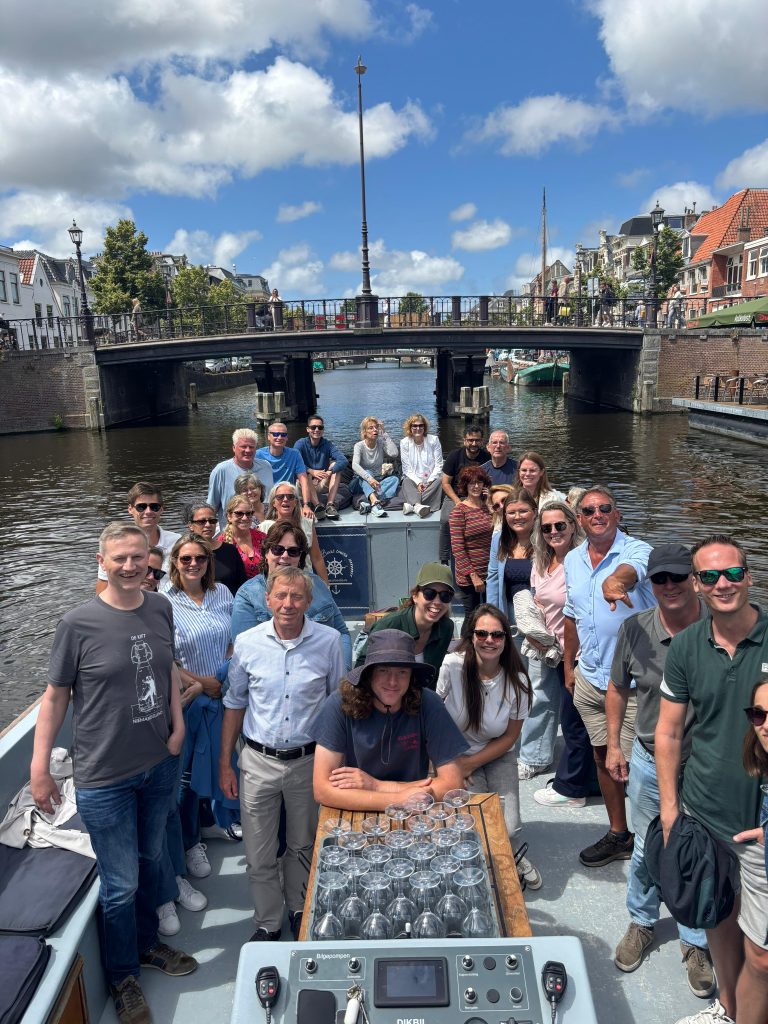
-
Which bridge is most often mentioned in travel blogs and reviews?
An analysis of popular travel blogs and online reviews reveals that the Gravestenen Bridge is the most frequently mentioned and praised by visitors. The combination of its picturesque appearance, rich history, and strategic location makes it a favorite among tourists. Many visitors describe the moment they pass under the bridge as a highlight of their cruise, with the echo of their voices and the interplay of light and shadow creating an almost magical experience.
The Catharijne Bridge comes in a close second in reviews, often praised for its impressive engineering design and the way it combines modern functionality with historic charm. Visitors are particularly impressed by the spectacle when the bridge opens to allow larger ships to pass, often described as a "dance of steel and water."How do international tourists describe their impressions of Haarlem's bridges?
- “A hidden gem in the Netherlands” – American tourist on the Melkbrug
- “Felt like a journey back in time to the Golden Age” – British visitor on the Gravestenen Bridge
- “Technical marvel with a soul” – German engineer on the Catharijne Bridge
- “Perfect mix of old and new” – Japanese photographer on the whole of Haarlem bridges
- “More romantic than Paris, more authentic than Amsterdam” – French travel blogger
How does the preservation of these bridges contribute to Haarlem's cultural heritage?
Haarlem's bridges are more than just functional connections; they are tangible pieces of history that tell the city's story. Preserving these architectural treasures contributes to preserving Haarlem's unique identity and cultural heritage. Each bridge represents a specific period in the city's history, from its medieval origins to its heyday during the Golden Age and the Industrial Revolution.
By carefully maintaining and restoring these bridges, Haarlem ensures that future generations can continue to enjoy this living history. Moreover, the bridges contribute to the city's character, make Haarlem attractive to tourists, and strengthen the sense of pride and community among the locals. Preserving the bridges is therefore not only a matter of historical importance but also of economic and social value to the community.What measures is the municipality of Haarlem taking to protect the bridges?
The municipality of Haarlem has developed a comprehensive program to protect and preserve its historic bridges. This includes regular inspections, preventative maintenance, and, where necessary, careful restoration. A team of experts, including historians, architects, and engineers, works together to ensure that all work is carried out with respect for the original structures and materials.
A key aspect of the protection policy is the use of innovative technologies to monitor the structural integrity of the bridges. Sensors are used to measure movements and loads, allowing potential problems to be identified and addressed early on. In addition, the municipality has established strict guidelines for traffic on the bridges to prevent excessive wear and tear.How are local residents involved in bridge maintenance?
- Volunteer programs for light maintenance and clean-up activities
- Educational workshops on the history and importance of the bridges
- Crowdfunding initiatives for specific restoration projects
- Annual 'Haarlem Bridge Day' with boat trips and activities
- Citizen consultations on major renovation plans
What makes a cruise along Haarlem's bridges an unforgettable experience?
A canal cruise along Haarlem's bridges is more than just a tourist attraction; it's an immersive journey through the history, architecture, and culture of this beautiful city. What makes this experience so special is the unique combination of visual splendor, historical depth, and the serene atmosphere that comes with cruising the canals.
As you sail beneath ancient arches and glide past graceful balustrades, you'll feel a connection to the generations that came before you. Each bridge tells its own story, from the medieval Gravestenen Bridge to the more modern Catharijne Bridge. The interplay between narrow, intimate canals and wider waterways like the Spaarne offers a diverse perspective on the city. It's this rich tapestry of impressions that makes a cruise along Haarlem's bridges an unforgettable experience.How does the experience of the bridges differ from the water compared to the shore?
Experiencing Haarlem's bridges from the water is fundamentally different than from the shore. From a boat, you get a unique perspective on the underside of the bridges, where you can often discover beautiful brickwork and hidden details not visible from the street. Their low position on the water makes the bridges appear more imposing, evoking a sense of awe and wonder.
Moreover, a boat tour offers the opportunity to see the bridges in their full context. You'll experience how they blend harmoniously with the surrounding architecture and the waterscape. The leisurely pace of a boat also gives you time to absorb every detail and appreciate the subtle differences between the bridges. These unique perspectives and the tranquility of the water make the experience from a boat incomparable to a stroll through the city.What sensory experiences make a bridge tour so special?
- Visual: The play of light and shadow under the bridges, reflections in the water
- Auditory: The echo of voices under the bridges, the soft lapping of water against the boat
- Tactile: The vibrations of the boat when you pass under a bridge
- Olfactory: The fresh water scent, mixed with the aromas of nearby cafes and restaurants
- Kinetic: The gentle rocking of the boat, the feeling of space when you pass a bridge
With this rich description of Haarlem's bridges and the experience of a canal cruise, I hope readers will be inspired to explore this beautiful city for themselves and discover the magic of its historic bridges.
What are the must-dos for a complete Haarlem bridge experience?
To complete your Haarlem bridge experience, there are a few must-dos you shouldn't miss. First, it's recommended to take both a daytime and an evening cruise. During the day, you can admire the architectural details of the bridges, while at night, the illuminated bridges create a magical atmosphere.
It's also worth taking the time to stroll along the quays. This gives you the chance to see the bridges up close and admire the surrounding historic buildings. Don't forget to bring your camera – the photogenic qualities of Haarlem's bridges invite you to create beautiful memories.- Take a day and evening cruise for different perspectives
- Stroll along the quays and over the bridges for a close-up experience
- Visit the Frans Hals Museum for paintings of old Haarlem cityscapes
- Enjoy a local beer on a terrace overlooking one of the iconic bridges
- Take a guided historical walking tour that highlights the stories behind the bridges
Finally, to truly complete your experience, we recommend sampling the local cuisine at one of the many canalside restaurants. Enjoy a delicious meal while gazing out over the water and bridges, and soak up Haarlem's unique atmosphere.
Conclusion
Haarlem's bridges are much more than simple crossings between banks; they are the living, breathing connections between the past and present of this charming Dutch city. From the medieval charm of the Gravestenen Bridge to the technical innovation of the Catharijne Bridge, each structure tells a unique story, contributing to the rich tapestry of Haarlem's history.
A canal cruise past these architectural gems offers visitors an unparalleled opportunity to experience the beauty and heritage of Haarlem. It's a journey that stimulates all the senses: the sight of centuries-old arches reflected in the water, the sound of water lapping against the banks, the aroma of the canals and nearby cafés, and the sense of wonder that arises as you cross each unique bridge.
Whether you're a history buff, an architecture enthusiast, or simply a traveler seeking beauty, Haarlem's bridges offer something for everyone. They invite contemplation of the ingenious architecture of our ancestors, inspire artistic expression, and create moments of tranquility and wonder in the midst of city life.
As Haarlem continues to develop and grow, these bridges remain as silent witnesses to the passage of time, connecting the past with the present and the future. They remind us that in a world of constant change, there are also places where history, beauty, and functionality seamlessly intertwine. A visit to Haarlem's bridges is therefore more than just a tourist activity; it's an immersion in the heart and soul of a city that cherishes and celebrates its heritage.
So when you get the chance to visit Haarlem, take the time to explore these bridges. Let yourself be carried away by their stories, savor their beauty, and experience the unique magic that can only be found where land and water meet under the protective arches of Haarlem's bridges. It's an experience that will stay with you long after you've left the city behind.